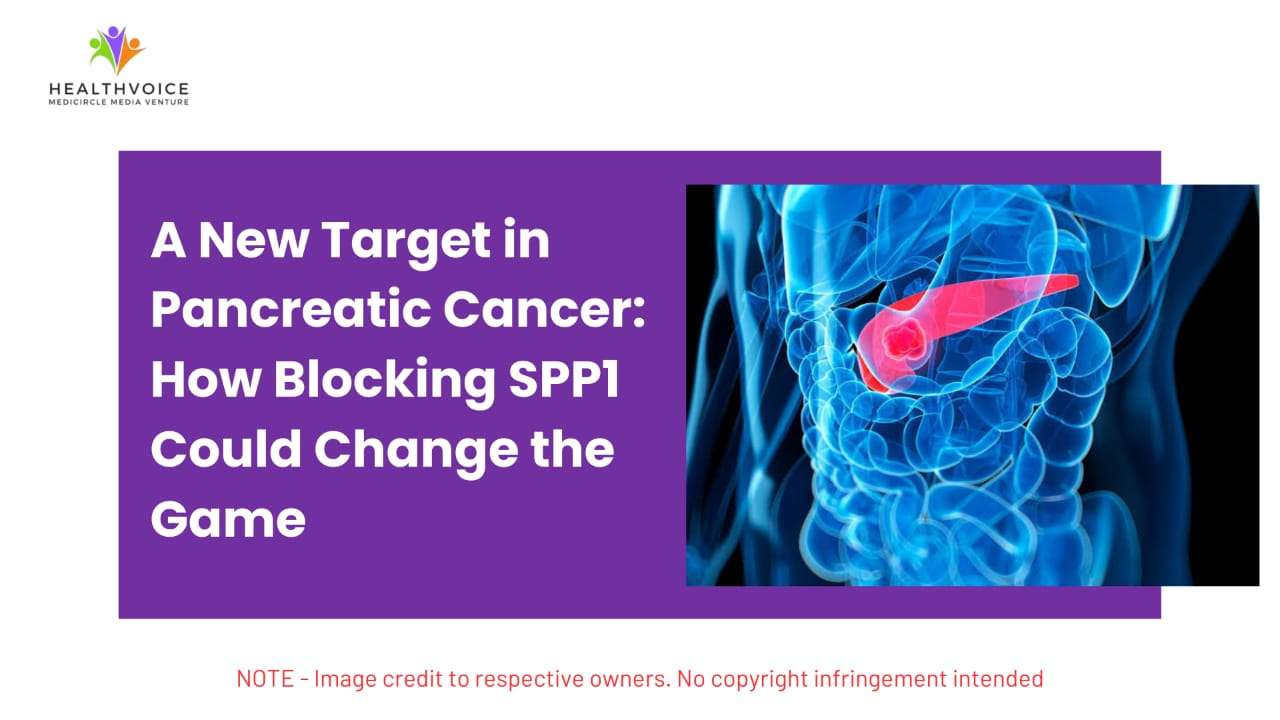A New Target in Pancreatic Cancer: How Blocking SPP1 Could Change the Game
While challenges remain in translating these findings into effective treatments, the breakthrough represents a milestone step toward improving outcomes, prolonging life, and restoring hope for thousands affected by pancreatic cancer each year.

Pancreatic cancer has long been one of the most feared diagnoses in oncology, often described as a silent killer. It ranks among the deadliest cancers, in large part because it is typically detected only when the disease is advanced. The aggressive nature of pancreatic ductal adenocarcinoma, the most common form of the disease, leaves patients with limited options and grim survival rates. For decades, scientists have struggled with the challenge of finding therapies that could meaningfully extend life and improve outcomes. Recent research from the Institute of Cancer Research (ICR) in London, however, has introduced a ray of hope, revealing a new target that could transform how this devastating cancer is treated.
The discovery centers on a protein called SPP1, which appears to play a critical role in the growth and spread of pancreatic tumours. In laboratory studies using mini tumours and mouse models, researchers found that blocking SPP1 slowed tumour growth dramatically and prevented metastasis, the process by which cancer spreads to other organs. Targeting this single protein could offer a path toward therapies that slow disease progression, improve patient survival, and provide precious time for additional treatment interventions.
Pancreatic cancer’s lethality stems from multiple factors. Symptoms are often vague or absent in early stages, leading to delayed diagnosis. By the time most patients are diagnosed, the cancer has already progressed, sometimes metastasizing to the liver, lungs, or other critical organs. In England and Wales, over 60% of patients receive a stage-four diagnosis. Survival statistics are alarming: nearly one in five patients does not survive beyond 30 days post-diagnosis. Conventional treatments, including surgery, chemotherapy, and radiation, offer limited benefit when the disease is already advanced, underscoring the urgent need for novel therapeutic strategies.
The identification of SPP1 as a key driver in pancreatic tumour progression represents a breakthrough in understanding the disease at a molecular level. Researchers discovered that SPP1 is elevated in aggressive pancreatic tumours, with higher levels correlating with poorer outcomes for patients. By switching off the gene responsible for producing this protein in lab-grown mini tumours, they observed significant reductions in tumour growth. Tumours became smaller, fewer in number, and less capable of invading surrounding tissue. These findings suggest that SPP1 is not merely associated with tumour growth it is a functional driver of malignancy, central to the cancer’s ability to spread.
Animal studies further reinforced these findings. In mice engineered to develop pancreatic ductal adenocarcinoma, the absence of SPP1 significantly extended survival. Mice that retained the gene for SPP1 did not survive beyond 50 days, whereas a notable 20% of mice with the gene blocked survived up to 400 days. Equally striking was the observation that tumours in these mice failed to metastasize, confirming SPP1’s role in driving cancer dissemination. Blocking the protein also increased levels of GREM1, a protein linked to limiting tumour spread, suggesting a potential network of interactions that could be exploited therapeutically.
The discovery has wide-ranging implications for treatment strategies. Current pancreatic cancer therapies are often limited by their inability to selectively target malignant cells while sparing healthy tissue. By focusing on a protein like SPP1, scientists hope to develop drugs that can specifically inhibit tumour growth and metastasis. Such targeted therapies could complement existing treatments, improving outcomes for patients who currently face a bleak prognosis. Researchers envision drugs that block SPP1 functioning as a frontline intervention for aggressive tumours or as adjuvant therapy alongside surgery and chemotherapy.
Experts in the field have recognized the potential impact of this research. Professor Axel Behrens, a stem cell biology expert at ICR, emphasized that targeting SPP1 could provide patients with a longer, healthier life. The protein’s role as a molecular switch controlling tumour aggression makes it a promising candidate for drug development. Professor Kristian Helin, chief executive of ICR, described the findings as “an important step toward more effective treatments,” highlighting the potential for this research to reshape the standard of care in pancreatic oncology.
The research highlights the value of lab-grown mini tumours as models for studying cancer biology. These three-dimensional organoids closely mimic human tumour behavior, allowing scientists to observe growth, drug response, and protein activity in a controlled environment. By applying gene editing techniques to switch off SPP1, researchers could directly measure its effect on tumour size, growth rate, and metastatic potential. This approach provides more precise insights than traditional cell cultures, offering a bridge between laboratory experiments and potential clinical applications.
Moreover, the findings illuminate a broader lesson about the molecular complexity of pancreatic cancer. Proteins like SPP1 do not act in isolation; they interact with networks of other molecules that influence tumour behavior. The observed increase in GREM1 when SPP1 was blocked suggests a cascade effect where inhibiting one protein can enhance the tumor-suppressing activity of others. Understanding these interactions is critical for designing multi-target therapies that are more effective than single-drug interventions.
Early detection remains a parallel priority in the fight against pancreatic cancer. Even the most promising therapies are less effective if the disease has already metastasized. Researchers stress that identifying patients at risk, improving diagnostic tools, and raising awareness of early symptoms are essential complements to drug development. SPP1-targeted therapies could be most effective when administered before cancer spreads extensively, highlighting the importance of integrating new molecular insights with public health strategies and screening programs.
The discovery also reinforces the need for continued investment in cancer research. Pancreatic cancer has historically received less attention than other common cancers, partly due to its relative rarity. However, its lethality makes it a high-priority target for innovation. Funding for molecular studies, clinical trials, and translational research is crucial for converting laboratory breakthroughs into real-world treatments. Public awareness and advocacy can help ensure that resources are allocated to diseases where new therapies could dramatically alter survival outcomes.
Clinical translation of these findings is the next critical step. Researchers plan to develop drugs that specifically inhibit SPP1, test their safety and efficacy in preclinical models, and ultimately advance to human clinical trials. The pathway from discovery to treatment is complex, involving rigorous testing, regulatory approvals, and careful monitoring of side effects. Nonetheless, the identification of a clear molecular target like SPP1 provides a concrete starting point for this journey.
The potential global impact of SPP1-targeted therapies cannot be overstated. Pancreatic cancer affects patients worldwide, with particularly poor outcomes in countries where early detection and access to specialized treatment are limited. A therapy that effectively blocks tumour growth and metastasis could significantly improve survival statistics, offering hope to thousands of patients annually. Beyond survival, slowing disease progression can enhance quality of life, reduce hospitalizations, and allow patients to participate in family and community life for longer periods.
This research also highlights the growing importance of precision medicine in oncology. Understanding the molecular drivers of cancer enables treatments tailored to individual patients, moving away from one-size-fits-all approaches. SPP1 could become a biomarker for aggressive pancreatic disease, helping clinicians identify patients most likely to benefit from targeted therapy. Combining molecular diagnostics with tailored treatments represents a paradigm shift in how cancer care is delivered.
The discovery of SPP1’s role also opens avenues for combination therapies. Inhibitors of this protein could be used alongside chemotherapy, immunotherapy, or radiation to enhance treatment effectiveness. By preventing tumour spread, SPP1-targeted drugs may create a therapeutic window in which conventional treatments are more successful. This dual approach could improve response rates, extend survival, and reduce the toxicity associated with high-dose chemotherapy, ultimately benefiting patient well-being.
The identification of SPP1 also has implications for other forms of cancer. Proteins involved in cell growth, adhesion, and metastasis often play roles across multiple tumour types. While the current research focuses on pancreatic ductal adenocarcinoma, future studies may explore whether SPP1 contributes to aggressive behavior in other cancers. If so, inhibitors developed for pancreatic cancer could have broader applications, amplifying their impact on oncology as a whole.
Ultimately, this discovery represents hope in a field often characterized by despair. Pancreatic cancer remains one of the most formidable challenges in medicine, but breakthroughs like SPP1 research show that progress is possible. By combining molecular insights, innovative laboratory models, and a commitment to patient outcomes, scientists are charting a path toward treatments that were previously unimaginable. Patients and families, long accustomed to limited options and poor prognosis, can now look toward a future where pancreatic cancer may be managed more effectively, and survival extended.
As the research continues, the lessons from SPP1 extend beyond pancreatic cancer. They highlight the importance of understanding disease at its most fundamental level, the power of targeted therapies, and the necessity of integrating laboratory discoveries with clinical realities. Investing in early detection, molecular research, and patient-centered approaches is essential for transforming cancer care globally.
In conclusion, the identification of SPP1 as a key driver in pancreatic ductal adenocarcinoma marks a turning point in cancer research. By blocking this protein, scientists have demonstrated the possibility of slowing tumour growth, preventing metastasis, and extending survival in experimental models. The work showcase the potential of targeted therapies, precision medicine, and molecular biology to offer real hope to patients facing one of the deadliest forms of cancer. While challenges remain in translating these findings into effective treatments, the breakthrough represents a milestone step toward improving outcomes, prolonging life, and restoring hope for thousands affected by pancreatic cancer each year. In a disease defined by its aggressiveness and high mortality, SPP1 offers a target, a strategy, and a vision for a future where pancreatic cancer is no longer a death sentence but a challenge science is steadily learning to meet.
 Sunny Parayan
Sunny Parayan
#healthvoice #PancreaticCancer #CancerResearch #OncologyBreakthroug #TargetedTherapy #CancerTreatment #CancerAwareness #MedicalResearch #FutureOfOncology #CancerSurvivor #LifeSavingScience
